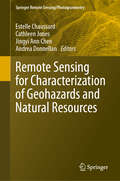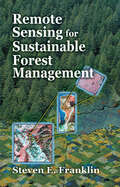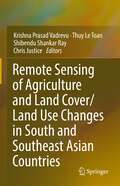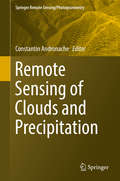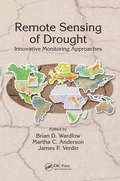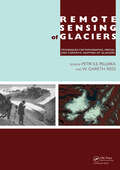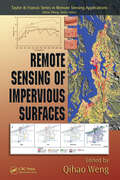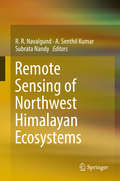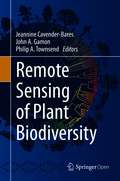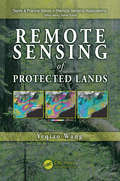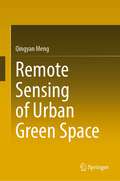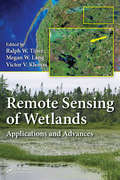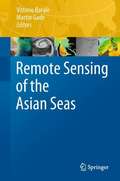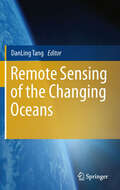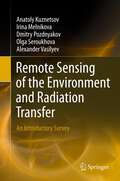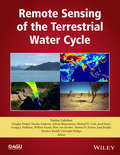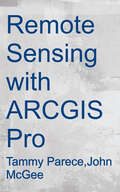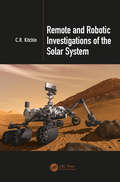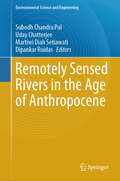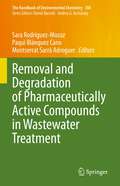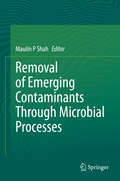- Table View
- List View
Remote Sensing for Characterization of Geohazards and Natural Resources (Springer Remote Sensing/Photogrammetry)
by Andrea Donnellan Estelle Chaussard Cathleen Jones Jingyi Ann ChenThis book provides insights from a geoscientist’s perspective into the benefits and the potential of remote sensing methods to address problems with a high social impact: identifying the drivers of geohazards and developing new methods for monitoring natural resources. The fields covered include volcanic hazards, seismic hazards, landslide hazards, land subsidence hazards and monitoring of natural resources through the use and combination of various remote sensing techniques and modelling approaches. This book should spark collaborations and encourage readers to think beyond disciplines or techniques, as well as enable readers to build their own workflow depending on their study of interest. It provides a much-needed comprehensive review of recent advances that remote sensing methods have brought to geohazards and resources research. It is unique in the way that it unifies geohazards and natural resources research to highlight cross-field advancements and potential areas for multiple fields of science to collaborate. The book intends to provide both a basic understanding of the remote sensing methods used in geohazards and natural resources sciences, with appropriate referencing for readers wishing to further their technique-specific learning, and a detailed application of these methods to a variety of sustainability problems. It aims at providing the reader with workflows for combining multiple techniques with demonstrated results in a variety of disciplines. This approach makes the book useful for both students learning about geohazards and resources, learning about remote sensing methods, and for researchers intending to expand their skill set using methods that have been applied to other fields. This book provides an introduction to each remote sensing method with references for in-depth technical learning which will benefit students in Remote Sensing courses.
Remote Sensing for Food Security (Sustainable Development Goals Series)
by Felix KoganThis volume gathers a variety of applications for remote sensing of vegetation health (VH) and concretely shows how this information can be used in service of ending hunger and of ensuring future food security. In this book’s ten chapters, Dr. Felix Kogan, one of the most prolific scientists in this sphere, shows how a new VH method, designed from operational environmental satellite data, can be used to provide advanced predictions of agricultural losses, helping to enhance food security and reducing the number of hungry people. Topics covered include the scientific basis of the VH method, drought monitoring, prediction of short-term agricultural yield and crop insurance, and impacts of long term climate variability and change on food security. A short discussion on VH for human health-related topics such as detection and prediction of malaria and fire risk is included as well.
Remote Sensing for Malaria: Monitoring and Predicting Malaria from Operational Satellites (Springer Remote Sensing/Photogrammetry)
by Felix KoganThis book presents research using high-resolution operational satellite data for monitoring and assessing numerically how to reduce the area and intensity of malaria outbreaks. Satellite data and imageries a powerful and effective tool for malaria monitoring and reduction of the number of affected people as it bypasses the limitations imposed by the dearth of near-the-ground weather data in many malaria-prone areas. With this in mind, this volume provides readers with:In-depth information in monitoring signs of malaria from operational polar-orbiting satellitesExamples of country-specific models for predicting malaria area (1 and 4 km2 resolution) and intensityInformation on the how the effects of climate change on malaria outbreak area and intensity can be monitoredA new Vegetation Health (VH) methodology to estimate vegetation moisture, temperature and moisture/temperature conditions as indicators of malaria vector activityAdvice to users on the application of VH technology for early assessments of malaria area, intensity and risk levelRemote Sensing for Malaria is intended for an audience of public health practitioners, environmentalists, and students and researchers working in spatial epidemiology and disease prevention.
Remote Sensing for Sustainable Forest Management
by Steven E. FranklinAs remote sensing data and methods have become increasingly complex and varied - and increasingly reliable - so have their uses in forest management. New algorithms have been developed in virtually every aspect of image analysis, from classification to enhancements to estimating parameters. Remote Sensing for Sustainable Forest Management reviews t
Remote Sensing of African Mountains: Geospatial Tools Toward Sustainability
by Samuel Adelabu Abel Ramoelo Adeyemi Olusola Efosa AdagbasaThis edited volume focuses on the use of remote sensing techniques to assess and monitor mountainous ecosystems in Africa, with a focus on tracking changes related to climate change and human activity. The book is timely, as the interaction of mountain environmental dynamics with conservation and sustainability is an under-researched issue. The chapters in this volume use remotely sensed data to study a variety of topics related to mountains and their ecosystems, including but not limited to vegetation, energy systems, environmental hazards, ecosystem services, diseases, climatic shifts, geological formations and geomorphological dynamics. The ability to monitor, assess and analyze mountainous regions is aided by the availability of remote sensing products such as optical and microwave sensors and low-cost unmanned aerial vehicles (UAVs). The works presented here push the frontier of knowledge on mountain studies and will help shape local, national and global assessments and policies, including efforts toward the achievement of the African Agenda 2063. The book will be of interest to researchers and students in remote sensing, geography, ecology and sustainability, as well as to government organizations and conservation specialists.
Remote Sensing of Agriculture and Land Cover/Land Use Changes in South and Southeast Asian Countries
by Krishna Prasad Vadrevu Chris Justice Thuy Le Toan Shibendu Shankar RayThis book sheds new light on the remote sensing of agriculture in South/Southeast Asian (S/SEA) countries. S/SEA countries are growing rapidly in terms of population, industrialization, and urbanization. One of the critical challenges in the region is food security. In S/SEA, although total food production and productivity have increased in previous decades, in recent years, the growth rate of food production has slowed down, mostly due to land use change, market forces and policy interventions. Further, the weather and climate systems in the region driven primarily by monsoon variability are resulting in droughts or flooding, impacting agricultural production. Therefore, monitoring crops, including agricultural land cover changes at regular intervals, is essential to predict and prepare for disruptions in the food supply in the S/SEA countries. The current book captures the latest research on the remote sensing of agricultural land cover/ land use changes, including mapping and monitoring crops, crop yields, biophysical parameter retrievals, multi-source data fusion for agricultural applications, and chapters on decision making and early warning systems for food security. The authors of this book are international experts in the field, and their contributions highlight the use of remote sensing and geospatial technologies for agricultural research and applications in South/Southeast Asia.
Remote Sensing of Clouds and Precipitation (Springer Remote Sensing/photogrammetry Ser.)
by Constantin AndronacheThis book presents current applications of remote sensing techniques for clouds and precipitation for the benefit of students, educators, and scientists. It covers ground-based systems such as weather radars and spaceborne instruments on satellites. Measurements and modeling of precipitation are at the core of weather forecasting, and long-term observations of the cloud system are vital to improving atmospheric models and climate projections. The first section of the book focuses on the use of ground-based weather radars to observe and measure precipitation and to detect and forecast storms, thunderstorms, and tornadoes. It also discusses the observation of clouds using ground-based millimeter radar. The second part of the book concentrates on spaceborne remote sensing of clouds and precipitation. It includes cases from the Tropical Rainfall Measuring Mission (TRMM) and the Global Precipitation Measurement (GPM) mission, using satellite radars to observe precipitation systems. Then, the focus is on global cloud observations from the ClaudSat, Cloud-Aerosol Lidar and Infrared Pathfinder Satellite Observation (CALIPSO), including a perspective on the Earth Clouds, Aerosols, and Radiation Explorer (EarthCARE) satellite. It also addresses global atmospheric water vapor profiling for clear and cloudy conditions using microwave observations. The final part of this volume provides a perspective into advances in cloud modeling using remote sensing observations.
Remote Sensing of Drought: Innovative Monitoring Approaches (Drought and Water Crises)
by Brian D. Wardlow Martha C. Anderson James P. VerdinRemote Sensing of Drought: Innovative Monitoring Approaches presents emerging remote sensing-based tools and techniques that can be applied to operational drought monitoring and early warning around the world. The first book to focus on remote sensing and drought monitoring, it brings together a wealth of information that has been scattered through
Remote Sensing of Glaciers: Techniques for Topographic, Spatial and Thematic Mapping of Glaciers
by Petri Pellikka W. Gareth ReesGlaciers and ice sheets have been melting significantly during recent decades, posing environmental threats at local, regional and global scales. Changes in glaciers are one of the clearest indicators of alterations in regional climate, since they are governed by changes in accumulation (from snowfall) and ablation (by melting of ice). Glacier chan
Remote Sensing of Impervious Surfaces (Remote Sensing Applications Series)
by Qihao WengRemote sensing of impervious surfaces has matured using advances in geospatial technology so recent that its applications have received only sporadic coverage in remote sensing literature. Remote Sensing of Impervious Surfaces is the first to focus entirely on this developing field. It provides detailed coverage of mapping, data extraction,
Remote Sensing of Land Use and Land Cover in Mountain Region: A Comprehensive Study at the Central Tibetan Plateau
by Duo ChuThis book presents the spatial and temporal dynamics of land use and land cover in the central Tibetan Plateau during the last two decades, based on various types of satellite data, long-term field investigation and GIS techniques. Further, it demonstrates how remote sensing can be used to map and characterize land use, land cover and their dynamic processes in mountainous regions, and to monitor and model relevant biophysical parameters.The Tibetan Plateau, the highest and largest plateau on the Earth and well known as “the roof of the world,” is a huge mountainous area on the Eurasian continent and covers millions of square kilometers, with an average elevation of over 4000 m. After providing an overview of the background and an introduction to land use and land cover change, the book analyzes the current land use status, dynamic changes and spatial distribution patterns of different land-use types in the study area, using various types of remotely sensed data, digital elevation models and GIS spatial analysis methods to do so. In turn, it discusses the main driving forces, based on the main physical environment variables and socioeconomic data, and provides a future scenario analysis of land use change using a Markov chain model. Given its scope, it provides a valuable reference guide for researchers, scientists and graduate students working on environmental change in mountainous regions around the globe, and for practitioners working at government and non-government agencies.
Remote Sensing of Northwest Himalayan Ecosystems
by R. R. Navalgund A. Senthil Kumar Subrata NandyHimalaya, one of the global biodiversity hotspots, is the abode of a variety of flora and fauna. The Himalayan ecosystems have immense ecological, socioeconomic, and aesthetic significance as they provide a wide range of ecosystem services. The northwest Himalaya (NWH), covering three states of India viz., Uttarakhand, Himachal Pradesh, and Jammu and Kashmir, starts from the foothills of Shivaliks in the south and extends to the greater Himalaya in the north. This region is also the source of some of the major rivers of India. With the increase in population, the NWH ecosystems have been under threat due to deforestation, loss of biodiversity, expansion of agriculture and settlement, overexploitation of natural resources, habitat loss and fragmentation, poaching, mining, construction of roads and large dams, and unplanned tourism. The Himalaya being young and geotectonically active, remains inherently unstable, fragile, and prone to natural disasters. Climate change is also likely to impact the Himalayan cryosphere drastically. Recognizing the importance of the Himalaya, a National Mission for Sustaining the Himalayan Ecosystem, one of the eight missions under the National Action Plan on Climate Change (NAPCC) of Govt. of India, to conserve biodiversity, forest cover and other ecological values in the Himalayan region has been taken up.Spaceborne remote sensing with its ability to provide synoptic and repetitive coverage has emerged as a powerful tool for assessment and monitoring of the Himalayan resources and phenomena. Indian Institute of Remote Sensing, Dehradun has taken up a number of studies in the fields of geology, water resources, forestry, agriculture, urban settlement, etc., over the last decade. The book summarises the work carried out in different disciplines, illustrated with tables and figures and a host of relevant references. It is hoped that the book serves as an excellent reference of immense value to the students, researchers, professors, scientists, professionals, and decision makers working in the NWH region.
Remote Sensing of Plant Biodiversity
by Jeannine Cavender-Bares John A. Gamon Philip A. TownsendThis Open Access volume aims to methodologically improve our understanding of biodiversity by linking disciplines that incorporate remote sensing, and uniting data and perspectives in the fields of biology, landscape ecology, and geography. The book provides a framework for how biodiversity can be detected and evaluated—focusing particularly on plants—using proximal and remotely sensed hyperspectral data and other tools such as LiDAR. The volume, whose chapters bring together a large cross-section of the biodiversity community engaged in these methods, attempts to establish a common language across disciplines for understanding and implementing remote sensing of biodiversity across scales. The first part of the book offers a potential basis for remote detection of biodiversity. An overview of the nature of biodiversity is described, along with ways for determining traits of plant biodiversity through spectral analyses across spatial scales and linking spectral data to the tree of life. The second part details what can be detected spectrally and remotely. Specific instrumentation and technologies are described, as well as the technical challenges of detection and data synthesis, collection and processing. The third part discusses spatial resolution and integration across scales and ends with a vision for developing a global biodiversity monitoring system. Topics include spectral and functional variation across habitats and biomes, biodiversity variables for global scale assessment, and the prospects and pitfalls in remote sensing of biodiversity at the global scale.
Remote Sensing of Protected Lands (Remote Sensing Applications Series)
by Yeqiao WangNational parks, wildlife refuges and sanctuaries, natural reserves, conservation areas, frontier lands, and marine-protected areas are increasingly recognized as essential providers of ecosystem services and biological resources. As debates about climate change and sustainability intensify, protected areas become more important as indicators of eco
Remote Sensing of Urban Green Space
by Qingyan MengThis book presents a systematic study of urban green space remote sensing from multi-dimensional and multi-scale technologies. On the basis of introducing the connotation, science and application value of urban green space, this book focuses on the two-dimensional and three-dimensional information extraction technology of urban vegetation, two-dimensional and three-dimensional measurement technology of urban green space and multi-scale perception technology and discusses the remote sensing evaluation method of urban green space. By exploring the technical advantages of ‘satellite remote sensing + aerial remote sensing + near-ground remote sensing’, urban green space remote sensing promotes the development of urban vegetation research from two-dimensional to three-dimensional observation, so that the quantity, quality and human perception of urban vegetation can be measured. In each chapter, an individual technology/method is introduced, and several cases are cited to demonstrate its practical application. This book offers a valuable reference guide for practitioners in urban planning, landscape greening, environmental protection and urban management, as well as teachers and graduate students engaged in urban remote sensing research.
Remote Sensing of Wetlands: Applications and Advances
by Victor V. Klemas Ralph W. Tiner Megan W. LangEffectively Manage Wetland Resources Using the Best Available Remote Sensing TechniquesUtilizing top scientists in the wetland classification and mapping field, Remote Sensing of Wetlands: Applications and Advances covers the rapidly changing landscape of wetlands and describes the latest advances in remote sensing that have taken place over the pa
Remote Sensing of the Asian Seas
by Vittorio Barale Martin GadeA wide variety of marginal basins, ranging from polar to equatorial regions, and a few sizeable enclosed basins, can all be included among the Asian Seas. The Arctic Ocean shelf seas off Siberia; the sheltered basins along the Pacific Ocean’s western rim; the coastal seas of the northernmost Indian Ocean, including the semi-enclosed Red Sea and Persian Gulf; the Caspian Sea, the remnants of the Aral Sea and a score of brackish or freshwater lakes, such as Lake Balkhash and Lake Baykal; all exhibit a multiplicity of environmental features and processes. Understanding the peculiarities of such a large and varied collection of marine and coastal types requires integrated observation systems, among which orbital remote sensing must play an essential role. This volume reviews the current potential of Earth Observations in assessing the many Asian seascapes, using both passive and active techniques in diverse spectral regions, such as measuring reflected visible and near-infrared sunlight and surface emissions in the thermal infrared and microwave range, or surface reflection of transmitted radar pulses in the microwave range. An in-depth evaluation of the available spectral regions and observation techniques, as well as of novel multi-technique methods, ensures that suitable tools are indeed accessible for exploring and managing the wealth of resources that the Asian Seas have to offer.
Remote Sensing of the Changing Oceans
by Danling TangRemote Sensing of the Changing Oceans is a comprehensive account of the basic concepts, theories, methods and applications used in ocean satellite remote sensing. The book provides a synthesis of various new ideas and theories and discusses a series of key research topics in oceanic manifestation of global changes as viewed from space. A variety of research methods used in the analysis and modeling of global changes are introduced in detail along with numerous examples from around the world's oceans. The authors review the changing oceans at different levels, including Global and Regional Observations, Natural Hazards, Coastal Environment and related scientific issues, all from the unique perspective of Satellite Observation Systems. Thus, the book not only introduces the basics of the changing oceans, but also new developments in satellite remote sensing technology and international cooperation in this emerging field. Danling Tang (Lingzis) received her Ph.D from Hong Kong University of Science and Technology. She conducted research and teaching in Hong Kong, USA, Japan, and South Korea for more than 10 years; in 2004, she received "100 Talents Program of Chinese Academy of Sciences" and returned to China. She was a professor of Fudan University, and now is a Leading Professor of "Remote Sensing of Marine Ecology and Environment" at the South China Sea Institute of Oceanology, Chinese Academy of Sciences. Dr. Tang has been working on satellite remote sensing of marine ecology and environment; her major research interests include ocean dynamics of phytoplankton bloom, global environmental changes, and natural hazards. Dr. Tang has organized several international conferences, workshops, and training, she also services as member of organizing committee for several international scientific organizations; she was the Chairman of the 9th Pan Ocean Remote Sensing Conference (PORSEC 2008), and currently is the President-elect of PORSEC Association.
Remote Sensing of the Environment and Radiation Transfer
by Alexander Vasilyev Dmitry Pozdnyakov Irina Melnikova Olga Seroukhova Anatoly KuznetsovThe interaction of the solar and heat radiation with the atmosphere and surface is the subject of the book. It is useful also for wide circle scientists involved in environmental studies. The book contains the description of 17 computer studying programs supporting different topics of courses. It includes only the base ground for comprehension of key topics and provides the accomplishment of practical works with using specially elaborated computer programs. Themes of practical works reflect main sections of mentioned courses of lectures. The packet of computer programs is added for solution of direct and inverse problems. It promotes deep and reliable comprehension of corresponding topics by students. All described approaches and computer programs are valuable resources for solving radiative transfer problems and they could be used by students for courses and diploma studies concerned atmospheric optics.
Remote Sensing of the Terrestrial Water Cycle
by Venkataraman LakshmiRemote Sensing of the Terrestrial Water Cycle is an outcome of the AGU Chapman Conference held in February 2012. <P><P>This is a comprehensive volume that examines the use of available remote sensing satellite data as well as data from future missions that can be used to expand our knowledge in quantifying the spatial and temporal variations in the terrestrial water cycle. Volume highlights include: - An in-depth discussion of the global water cycle - Approaches to various problems in climate, weather, hydrology, and agriculture - Applications of satellite remote sensing in measuring precipitation, surface water, snow, soil moisture, groundwater, modeling, and data assimilation - A description of the use of satellite data for accurately estimating and monitoring the components of the hydrological cycle - Discussion of the measurement of multiple geophysical variables and properties over different landscapes on a temporal and a regional scale Remote Sensing of the Terrestrial Water Cycle is a valuable resource for students and research professionals in the hydrology, ecology, atmospheric sciences, geography, and geological sciences communities.
Remote Sensing with ArcGIS Pro
by Tammy E. Parece John A. McGeeRemotely sensed images are widely available and have countless potential applications. In the past, analyzing these images required specialized software. Esri’s ArcGIS® Pro software provides image analysis tools that both novice and experienced analysts can use. This manual provides a series of easy-to-understand, step-by-step tutorials to guide you through image acquisition and data analysis processes. By completing this series of tutorials, you will be able to: Search, select, and download satellite imagery from the USGS’s EarthExplorer Manipulate data in ArcGIS Pro Display Landsat 9 imagery (as well as imagery collected by other satellite and UAS platforms) Enhance and analyze remotely sensed imagery. Videos available through the Virginia Geospatial Extension Program / VirginiaView website (www.virginiaview.net) can be used as additional training resources to accompany this manual.
Remote and Robotic Investigations of the Solar System
by C.R. KitchinInterest in and knowledge of the techniques utilised to investigate our solar system has been growing rapidly for decades and has now reached a stage of maturity. Therefore, the time has now arrived for a book that provides a cohesive and coherent account of how we have obtained our present knowledge of solar system objects, not including the Sun. Remote and Robotic Investigations of the Solar System covers all aspects of solar system observations: the instruments, their theory, and their practical use both on Earth and in space. It explores the state-of-the-art telescopes, cameras, spacecraft and instruments used to analyse the interiors, surfaces, atmospheres and radiation belts of solar system objects, in addition to radio waves, gamma rays, cosmic rays and neutrinos. This book would be ideal for university students undertaking physical science subjects and professionals working in the field, in addition to amateur astronomers and anyone interested in learning more about our local astronomical neighbours.
Remotely Sensed Rivers in the Age of Anthropocene (Environmental Science and Engineering)
by Uday Chatterjee Subodh Chandra Pal Martiwi Diah Setiawati Dipankar RuidasThis book offers a geospatial technology approach to data mining techniques, data analysis, modeling, risk assessment, and visualization, as well as management strategies in many elements of river basin risks. This book investigates cutting-edge techniques based on open source software and R statistical programming Google Earth Engine and modeling in modern artificial intelligence techniques, with a particular emphasis on recent trends in data mining techniques and robust modeling in river basin management. It includes significant issues such as geomorphological hazards, climate change, catastrophic natural disasters, meteorological and agricultural drought monitoring, landslides or mudslides (mudflow), floods and flash floods, soil erosion, and land degradation. This book's contents are of interest to earth and environmental scientists, professionals, and policymakers. The book examines spatial modeling, risk evaluation of a drainage basin in the domain of environmental and social issues, management, and associated research. Due to poorly understood climate change and unclear man-made activity, there are several problems and uncertainties in studying earth's environmental circumstances, making it exceedingly difficult to analyze and make knowledgeable judgments. Many difficulties, on the other hand, are caused by mismanagement of present and future land, water, and forestry resources. It is also critical to use new technology and methods to improve and reinforce environmental protection. The link between the three devices, namely remote sensing (RS), GIS, and the R programming interface, is acknowledged in this respect. Land conservation measures, soil and water quality control, and new rules should all rely on correct measurements and predictions, and three technologies (RS, GIS, and R) and open access quantitative forecasting methodologies help with climate change and better management regulations. Nonetheless, this book serves as a feasible framework for studying current breakthroughs in geospatial artificial intelligence technologies and their relevance to the planet's environmental and socioeconomic concerns in a single volume.
Removal and Degradation of Pharmaceutically Active Compounds in Wastewater Treatment (The Handbook of Environmental Chemistry #108)
by Sara Rodriguez-Mozaz Paqui Blánquez Cano Montserrat Sarrà AdroguerThis book reviews water treatment technologies for the removal of pharmaceutically active compounds (PhACs). It provides the reader with an overview of state-of-the-art techniques and recent efforts to develop more sustainable approaches. After nearly two decades of research into the presence and impact of PhACs in the environment, they remain one of the hottest topics in the fields of environmental chemistry, toxicology and engineering. Accordingly, intensive research efforts are currently being devoted to water treatment technologies that can reduce the presence of these emerging contaminants in water bodies. This book examines various types of contaminated water from industry, hospitals and urban wastewater. It provides the reader with a range of potential solutions for water treatment and reuse, and addresses the advancement of analytical tools for evaluating the performance and efficiency of treatment technologies.
Removal of Emerging Contaminants Through Microbial Processes
by Maulin P ShahThe abundance of organic pollutants found in wastewater affect urban surface waters. Traditional wastewater management technologies focus on the removal of suspended solids, nutrients and bacteria, however, new pollutants such as synthetic or naturally occurring chemicals are often not monitored in the environment despite having the potential to enter the environment and cause adverse ecological and human health effects. Collectively referred to as "emerging contaminants," they are mostly derived from domestic activities and occur in trace concentrations ranging from pico to micrograms per liter. Environmental contaminants are resistant to conventional wastewater treatment processes and most of them remain unaffected, causing contamination of receiving water. This in turn leads to the need for advanced wastewater treatment processes capable of removing environmental contaminants to ensure safe fresh water sources. This book provides an up-to-date overview of the current bioremediation strategies, including their limitations, challenges and their potential application to remove environmental pollutants. It also introduces the latest trends and advances in environmental bioremediation, and presents the state-of-the-art in biological and chemical wastewater treatment processes. As such, it will appeal to researchers and policy-makers, as well as undergraduate and graduate environmental sciences students.
